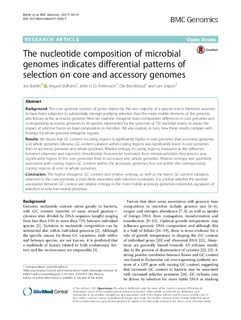| dc.contributor.author | Bohlin, Jon | |
| dc.contributor.author | Eldholm, Vegard | |
| dc.contributor.author | Pettersson, John | |
| dc.contributor.author | Brynildsrud, Ola Brønstad | |
| dc.contributor.author | Snipen, Lars-Gustav | |
| dc.date.accessioned | 2017-06-16T11:54:24Z | |
| dc.date.available | 2017-06-16T11:54:24Z | |
| dc.date.created | 2017-05-08T12:24:47Z | |
| dc.date.issued | 2017 | |
| dc.identifier.citation | BMC Genomics. 2017, 18 . | |
| dc.identifier.issn | 1471-2164 | |
| dc.identifier.uri | http://hdl.handle.net/11250/2446280 | |
| dc.description.abstract | Background: The core genome consists of genes shared by the vast majority of a species and is therefore assumed to have been subjected to substantially stronger purifying selection than the more mobile elements of the genome, also known as the accessory genome. Here we examine intragenic base composition differences in core genomes and corresponding accessory genomes in 36 species, represented by the genomes of 731 bacterial strains, to assess the impact of selective forces on base composition in microbes. We also explore, in turn, how these results compare with findings for whole genome intragenic regions. Results: We found that GC content in coding regions is significantly higher in core genomes than accessory genomes and whole genomes. Likewise, GC content variation within coding regions was significantly lower in core genomes than in accessory genomes and whole genomes. Relative entropy in coding regions, measured as the difference between observed and expected trinucleotide frequencies estimated from mononucleotide frequencies, was significantly higher in the core genomes than in accessory and whole genomes. Relative entropy was positively associated with coding region GC content within the accessory genomes, but not within the corresponding coding regions of core or whole genomes. Conclusion: The higher intragenic GC content and relative entropy, as well as the lower GC content variation, observed in the core genomes is most likely associated with selective constraints. It is unclear whether the positive association between GC content and relative entropy in the more mobile accessory genomes constitutes signatures of selection or selective neutral processes. | |
| dc.language.iso | eng | |
| dc.relation.uri | https://bmcgenomics.biomedcentral.com/articles/10.1186/s12864-017-3543-7 | |
| dc.title | The nucleotide composition of microbial genomes indicates differential patterns of selection on core and accessory genomes | |
| dc.type | Peer reviewed | |
| dc.type | Journal article | |
| dc.description.version | publishedVersion | |
| dc.source.pagenumber | 11 | |
| dc.source.volume | 18 | |
| dc.source.journal | BMC Genomics | |
| dc.identifier.doi | 10.1186/s12864-017-3543-7 | |
| dc.identifier.cristin | 1468790 | |
| cristin.unitcode | 7502,4,19,0 | |
| cristin.unitcode | 7502,4,9,0 | |
| cristin.unitname | Infeksjonsepidemiologi og modellering | |
| cristin.unitname | Molekylærbiologi | |
| cristin.ispublished | true | |
| cristin.fulltext | original | |
| cristin.qualitycode | 1 | |
